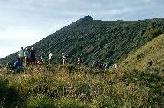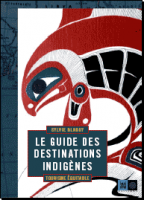Text : Lisa Choegyal
Photos : Heinz-Josef Heile.

The route of the three and four-day Rinjani Trek spans the Gunung Rinjani National Park in Lombok Indonesia and links the villages of Senaru via the crater rim and crater lake with Sembalun Lawang, or vice versa. Trekked independently, or supported by local guides and porters who carry the camp, it is considered one of the best treks in South-East Asia.
At 3,726m, Mt. Rinjani is the second highest volcanic peak in Indonesia, forming part of the celebrated "Ring of Fire". Its forested slopes rising directly from the sea create their own weather pattern and act as water-collectors for the whole island of Lombok. Gunung Rinjani National Park lies within the major transition zone (Wallaceae) where the flora and fauna of South-East Asia meets Australasia. The Park, one of the over 40 throughout Indonesia, was established in 1997 and has a rich biodiversity in its 41,330 ha area. For the people of Lombok, Sasak and Balinese alike, the volcano is revered as a sacred place and abode of deities. Its crater-lake is the destination of thousands of pilgrims who place offerings in the water and bathe away ailments in the hot springs.
First started in 1999 with New Zealand Government assistance, the goal of the Rinjani Trek Ecotourism Programme is to secure social, economic and conservation management benefits from the Programme in the Gunung Rinjani National Park. The Rinjani Trek is overseen by the Rinjani Trek Management Board (RTMB). The Rinjani Trek office is based in Mataram, the capital of Lombok.
Over 20 villages surround Gunung Rinjani National Park and most villagers are from the lower socio-economic groups of the Sasak people. Traditionally, Sasaks follow Wetu Telu, a form of Hinduism and Islam in which animistic beliefs and ancestral worship are blended. In the past 30 years migration has added more Sasak people from impoverished areas in the south of Lombok.
Tourism in Indonesia and Lombok suffered greatly in the past few years. Because of the relatively difficult nature of the challenging Rinjani Trek, trekking visitors are mainly young (under 35). International visitors come from Europe and Australia, and some from South-East Asian countries.
The community-managed Rinjani Trek Centre and Rinjani Information Centre are designed to educate tourists about the Park and to give indepth information about the natural and cultural environment, so they feel comfortable and enjoy their visit. Designed as a tourism focus for both trekkers and non-trekking visitors, displays have been developed in partnership with WWF Indonesia, Volcanology Section and the local people. They include sections on : Sasak cultural traditions and local village life ; Significance of the mountain in Sasak and Balinese culture ; Environmental and cultural do’s and don’ts ; Safety codes on the mountain, and how to organise your Rinjani Trek ; Flora and fauna of the Gunung Rinjani National Park and Volcanology.
Village walks have been developed with the local leaders and are guided by women and men to show key aspects of Sasak village life. In addition to working with the local guides, visitor surveys and incentive schemes further encourage tourists to respect local heritage and preserve the environment. Simple brochures reinforce Islamic and Hindu teachings that support the Park’s “pack-it-in pack-it-out” rubbish policy.
Trek guiding and village products have been developed with local leaders to highlight the deep cultural traditions of the Sasak and Balinese people. For example, a feature is made during village visits and guided walks of the rituals of the village Pemangku (spiritual leader), daily religious duties, village lifestyle and local farming techniques. Stories from the verbal tradition have been recorded in manuals and booklets as a guiding tool for villagers, both to promote local pride and enrich the visitor experience. The Centres’ displays prominently feature local culture and traditions. Day visitors and the more affluent trekkers make donations via the Centres and to the village cooperatives.
Location
The village of Senaru, an easy 2.5 hours drive from Mataram or Senggigi, is the main access to the National Park. As a non-trekking destination it is also popular - a cool, flower-filled mountain village stretching along a hillside spur above Bayan. Senaru has a range of accommodation in simple home stays (losmen), and a number of cafes serving delicious local specialities. The Rinjani Trek Centre at the trailhead offers displays, ecotourism activities, and visitor information. Village guides, including several local women, escort visits to the adjacent traditional village, three waterfalls, and a number of Village Walks. Circuits include the one hour Rice Terraces and Waterfall Walk, or discover the highlights of Senaru in a lovely half-day Senaru Panorama Walk.
Contact

Rinjani Trek Manager
Mr Asmuni Irpan
Email : rinjani@indo.net.id
Internet :
www.lomboksumbawa.com/rinjani/trek.htm
Other contact
NZAID-GRNP
Rinjani Trek Ecotourism Programme
C/- Lombok Raya Hotel
Jl. Panca Usaha No. 11, Mataram
Lombok, NTB, Indonesia
Tel/Fax : 62 370 641124, or
Hotel Tél. : 62 370 632305 x 1407
Email : rinjani@indo.net.id



